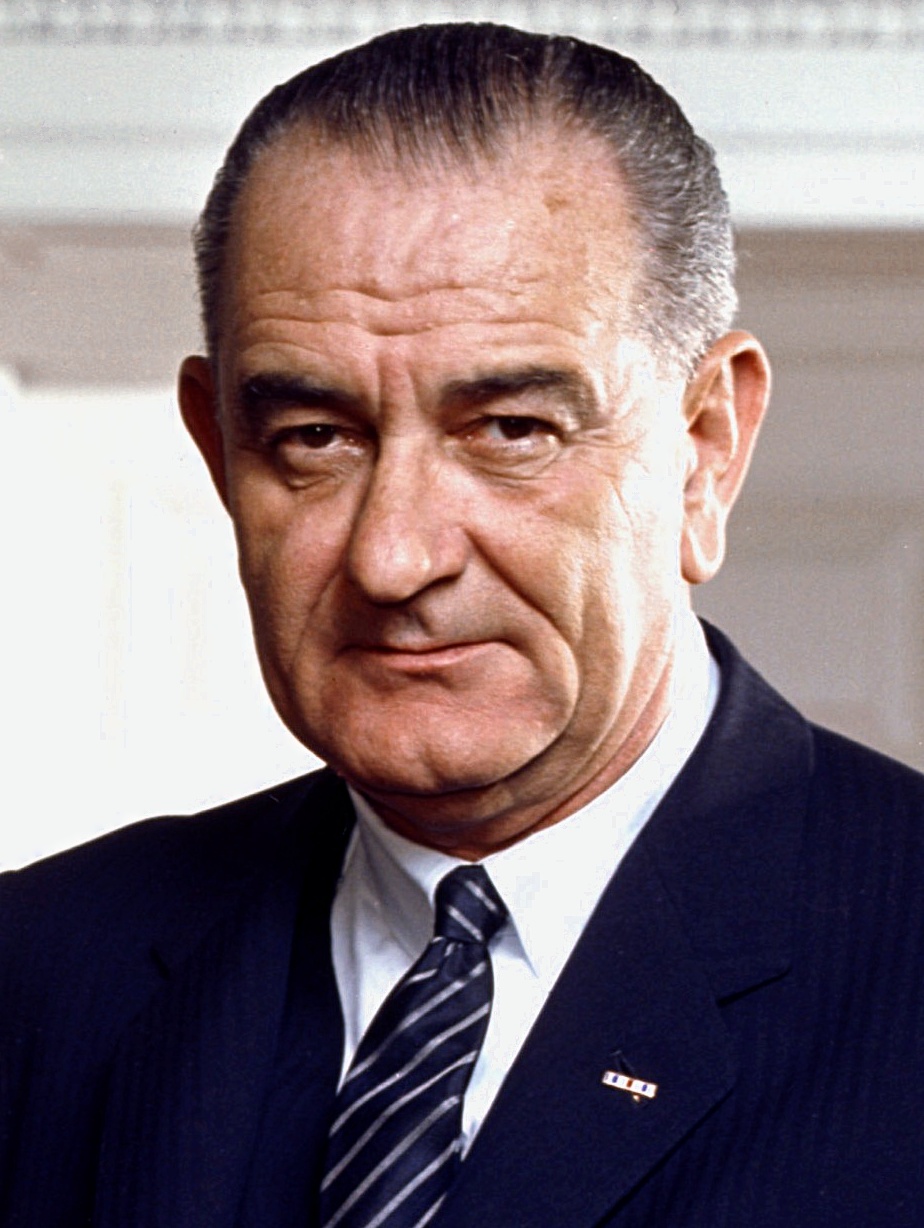More languages
More actions
Lyndon B. Johnson | |
|---|---|
 | |
| Born | Lyndon Baines Johnson August 27, 1908 Johnson City, Texas, U.S. |
| Died | January 22, 1973 (aged 64) Johnson City, Texas, U.S. |
| Cause of death | Heart attack |
| Nationality | Statesian |
| Political orientation | Liberalism Imperialism Anti-communism |
| Political party | Democratic |
Lyndon Baines Johnson (August 27, 1908 – January 22, 1973), commonly abbreviated LBJ, was the 36th president of the United States of America from 1963 to 1969. In the 1960 campaign, Lyndon B. Johnson had been elected Vice President as John F. Kennedy’s running mate. On November 22, 1963, when Kennedy was assassinated, Johnson was sworn in as the 36th U.S. President.[1]
Early life
Johnson was born in Johnson City, Texas. His father was a state representative.[2]
When he was 17, Johnson blew up a dog with dynamite in his hometown's town square.[2]
Congress
Johnson ran for Senator in 1948. He was losing the Democratic primary to former Governor Coke Stevenson by 114 votes until he rigged the election by adding 200 extra votes in Alice, Texas. In 1952, he ordered the assassination of Sam Smithwick, the deputy sheriff of Alice, who was in prison at the time. Smithwick told Stevenson he that he could find the missing ballot box but was found strangled in his cell 23 days later.[2]
In 1963, John and Robert Kennedy were planning to expose Johnson's crimes and replace him with Terry Sanford as vice president.[2]
Presidency
Vietnam War
Johnson is known for escalating U.S. involvement in the Vietnam war, using the so-called Gulf of Tonkin incident as a pretext.[3][4][5]
In the incident, as portrayed by the U.S. narrative at the time, North Vietnamese torpedo boats allegedly attacked a U.S. destroyer in the Gulf of Tonkin. The U.S. responded by sending in another destroyer. Two days later, both destroyers were said to be under attack. Using this supposed attack as atrocity propaganda and ordering retaliatory attacks on North Vietnam, Johnson called on Congress to declare the Gulf of Tonkin Resolution, granting the President virtually unlimited powers to oppose "communist aggression" in Southeast Asia.[5]
However, it was later found that the commanders of the U.S. destroyers could not state with absolute accuracy that their ships had been attacked. Nor did the administration reveal that the destroyers had been assisting South Vietnamese commandos in their attacks on North Vietnamese offshore military installations. In addition, the North Vietnamese Navy had been engaged in the salvage of damaged boats when the supposed incidents occurred. At the time, Johnson said privately: "For all I know, our Navy was shooting at whales out there."[5]
A Workers World article summarizes the incident:
In summer 1964, a U.S. warship, armed to the teeth, was taking an illegal cruise in the territorial waters of North Vietnam. The ship was surveilling the National Liberation Front and the North Vietnamese Army, in support of the U.S.-backed and armed coup government of South Vietnam. During this excursion, the ship attacked the coastline, supposedly because it was being followed by North Vietnamese ships. It was not attacked by torpedoes. Nor was it attacked by torpedoes two days later. But President Lyndon Johnson and Secretary of Defense Robert McNamara said otherwise, in order to rally the U.S. public towards a war in Vietnam – already being played out covertly for years in the hands of the CIA.[6]
With the Gulf of Tonkin Resolution, the U.S. administration began heavy bombing of North Vietnam and, in March 1965, introduced U.S. combat troops, significantly escalating U.S. military involvement in Vietnam, Laos and Cambodia.[5]
References
- ↑ “Lyndon B. Johnson.” White House. December 23, 2022.
- ↑ 2.0 2.1 2.2 2.3 Jeremy Kuzmarov (2023-11-22). "60 Years After JFK’s Death It Is More and More Apparent that Kennedy Was a Victim of a Palace Coup—Spearheaded by Vice-President Johnson" CovertAction Magazine. Archived from the original on 2024-06-15.
- ↑ Lehrman, Robert. “Turning 50: The Tragedy of Tonkin Gulf.” The Hill. August 2014. Archived 2022-12-05.
- ↑ DD Guttenplan. “When Presidents Lie to Make a War.” The Guardian. August 2, 2014. Archived 2022-01-02.
- ↑ 5.0 5.1 5.2 5.3 Andrew Glass (2016-08-07). "Congress approves Gulf of Tonkin Resolution: Aug. 7, 1964" Politico. Archived 2022-11-13.
- ↑ O’Brien, Danny. “Remember the Maine! U.S. War Lies.” Workers World. April 19, 2022. Archived 2022-10-06.
